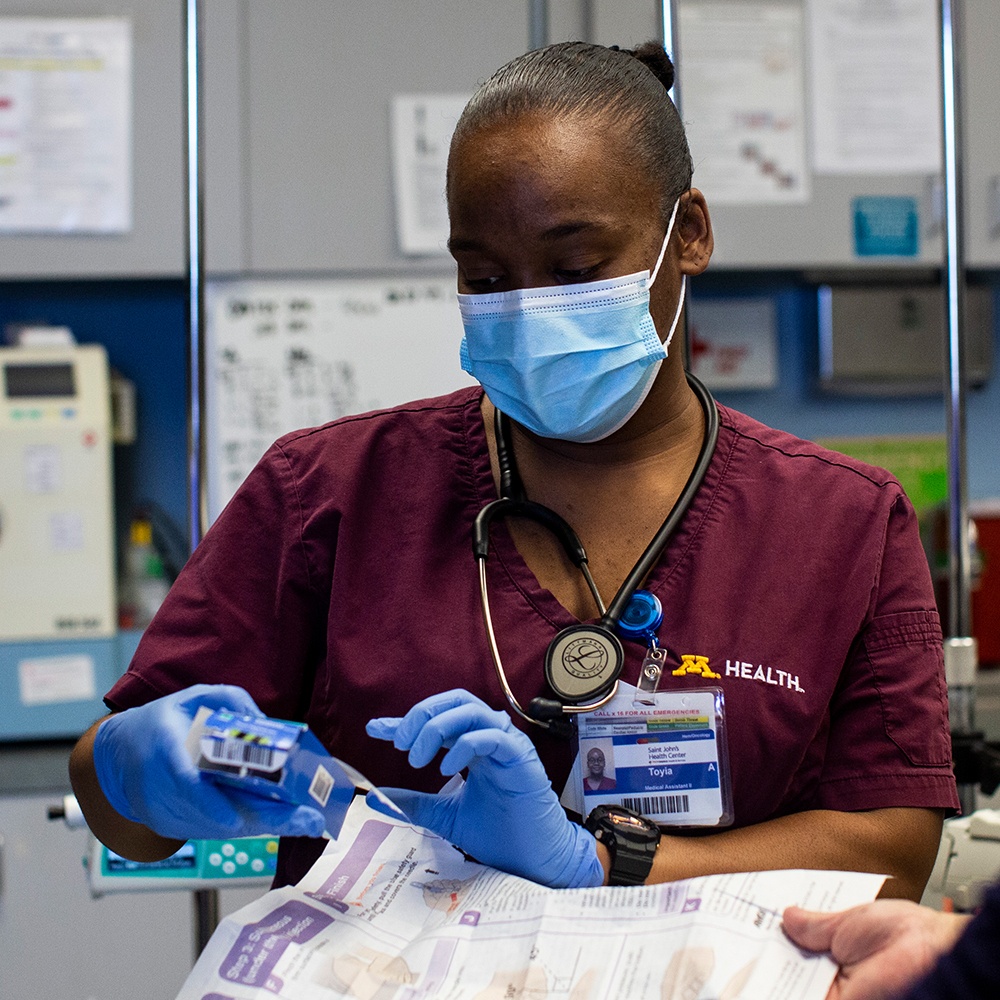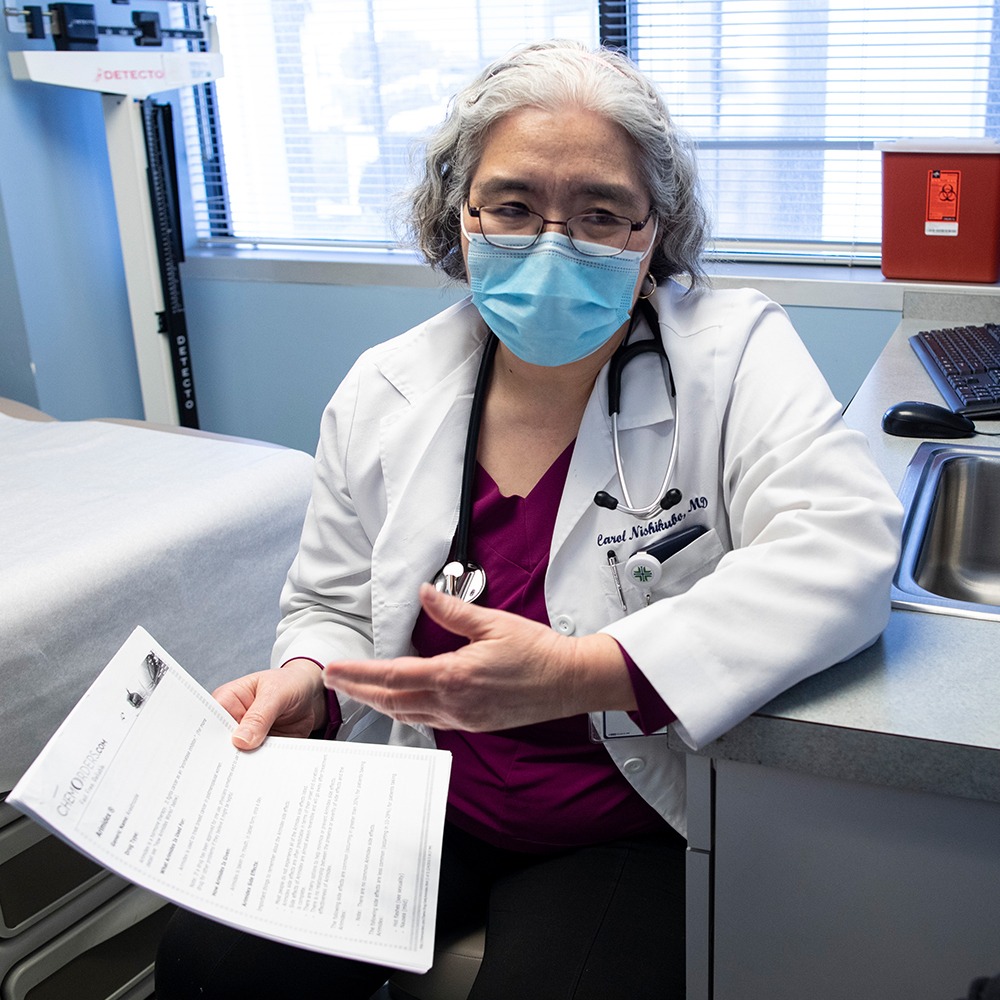Chemotherapy Infusions

Overview
Chemotherapy Infusions
Chemotherapy (‘chemo’ or ‘CTX’) is cancer treatment using one or more anticancer drugs. Such drugs are called ‘chemotherapeutic agents’. Usually, combinations of these drugs are used in standardized ‘chemotherapy regimens’. Chemotherapy given to cure a cancer is called ‘curative chemotherapy’, while drug use to prolong survival or relieve symptoms is called ‘palliative chemotherapy’.
Chemotherapeutic agents are non-specific cellular poisons that have a greater effect on tumor cells than on normal cells. They selectively inhibit rapidly dividing cells, which includes the tumor cells but also normal cells in hair follicles, bone marrow, the lining of the gastrointestinal tract, and others, leading to certain side effects such as hair loss, increased infections, gastrointestinal problems and pain in the lining of the mouth. These side effects are well known, and the aim of chemotherapy treatment is to use drugs doses and combinations that have a maximal effect on tumor cells and a minimal effect on normal cells.
Chemotherapeutic agents may act in different ways on tumor cells, hence their use in tried and tested chemotherapeutic regimens (see the Table). Some agents inhibit cell division or damage DNA. The use of a DNA repair inhibitor at the same time amplifies the effect of drugs damaging DNA. Other agents block metabolic pathways within cells, a process called ‘signal transduction’. These drugs inhibit the growth-promoting effects of hormones (estrogen in breast cancer, testosterone in prostate cancer). This is known as ‘hormonal therapy’. Growth signals can also be blocked by drugs targeting certain enzymes within the cells. One example is ‘receptor tyrosine kinase’. The use of these agents is called ‘targeted therapy’.
The use of chemotherapeutic agents in chemotherapy, hormonal therapy or targeted therapy is generally a ‘systemic therapy’ because drugs are infused into a vein and they reach all parts of the system, the whole body. In theory, systemically delivered drugs are able to reach tumor cells in any anatomical location, in all organs and tissues. Systemic therapy is often used in conjunction with ‘local therapy’ at the site of the tumor using surgery, radiation or hyperthermia (heat) therapy.
Chemotherapy may be given for different reasons. These are:
- Induction chemotherapy: first line treatment to cure a cancer
- Consolidation chemotherapy: the same drug given after remission, to prevent recurrence
- Intensification chemotherapy: a different drug given after remission, to prevent recurrence
- Combination chemotherapy: the simultaneous use of drugs acting differently to minimize side effects and toxicity
- Neoadjuvant chemotherapy: drugs give before a local therapy (surgery or radiation), to reduce the size of the tumor and limit metastasis
- Adjuvant chemotherapy: drugs given after a local treatment (surgery, radiation) to remove any residual tumor and prevent metastasis
- Maintenance chemotherapy: repeated low doses of drugs to prolong remission
- Salvage or palliative chemotherapy: drugs given to tumor burden and increase life expectancy
Because each dose of chemotherapy kills only some of the tumor cells (fractional kill), further doses are required to kill more tumor cells and reduce tumor size. Therefore, chemotherapy is given repeatedly in ‘treatment cycles’.
The frequency and duration of treatment is designed to limit toxicity. The dosage is calculated according to formulas that take into account your height, weight and body surface area. However, people vary widely in their response to drugs. Give too little, and the tumor survives. Give too much and there is toxicity. Hence, the concept is to find the right doses of drugs for the patient. This is called individualized or personalized treatment.
Drugs
Drugs Used in Chemotherapy
Several different types of drug are used for chemotherapy. These are alkylating agents, antimetabolite drugs, anti-microtubule agents, topoisomerase inhibitors and cytotoxic antibiotics.
Alkylating Agents
Alkylating agents cause the strands of DNA in the cell to stick together and to break when the cell tries to divide. Treatment with alkylating agents work best in combination with drugs that inhibit DNA repair. Unfortunately, these drugs also damage other biologically important molecules besides DNA.
Some examples of alkylating agents are shown below according to their chemical group.
Nitrogen mustards
cyclophosphamide, melphalan, chlorambucil and busulphan
Nitrosoureas
nitroso-methylurea, carmustine, lomustine and streptozotocin
Tetrazines
dacarbazine, mitolomide and temolozide
Arizidines
thiotepa, mitomycin and diaziquone
Cisplatins
cisplatin, carboplatin and oxyplatin
Non-classical
procarbazine and hexamethylmelamine
Antimetabolite Drugs
Antimetabolite drugs are similar to nucleotides, the building blocks of DNA and RNA. These drugs work either by blocking the enzymes required for DNA synthesis or by becoming incorporated into DNA and RNA. Hence, cell division is blocked.
There are subtypes of the anti-metabolites. Some examples are shown here.
Anti-folates
methotrexate and premetrexed
Fluoropyrimidines
fluorouracil and capecitabine
Deoxynucleoside analogues
cytarabine, gemcitabine, decitabine, azacytidine and pentastatin
Thiopurines
thioguanine and mercaptopurine
Anti-microtubule Agents
Every cell has an internal scaffold made of ‘microtubules’ These affect cell division. They also govern cell shape, movement and the distribution of various molecules within the cell. Microtubules are dynamic structures, being constantly broken down and rebuilt. Anti-microtubule agents were originally isolated from plants. There are two subtypes of anti-microtubule agents with directly contrasting actions. Vinca alkaloids prevent the assembly of microtubules, whereas taxanes prevent their disassembly. Both mechanisms block cell division. They also suppress the development of blood vessels within the tumor that would otherwise bring oxygen and nutrients to the cancer.
Examples of both subtypes of anti-microtubule agents, natural and synthetic, are shown here.
Vinca alkaloids
Vincristine, vinblastine, vinorelbine, vinesine and vinflunine
Taxanes
paclitaxel and docetaxel
Topoisomerase Inhibitors
Topoisomerase enzymes are required for the folding of DNA and proteins in cells. DNA is like a twisted rope that has to unfold before cell division can occur. Inhibition of DNA folding and unfolding prevents cell division. Hence, topoisomerase inhibitors are given as anti-cancer drugs.
There are two topoisomerase enzymes, numbered I and II. Some examples are shown here.
- Topoisomerase I inhibitors: campothecin, irinotecan and topotecan
- Topoisomerase II inhibitors can be divided into two groups.
- Topoisomerase II poisons: etoposide, doxorubicin, mitoxantrone and teniposide
- Catalytic inhibitors: novobiocin, merbarone and aclarubicin
Cytotoxic Antibiotics
The cytotoxic antibiotics are a varied group of drugs that have various mechanisms of action. Most interrupt cell division. The way they work overlaps with other drug subtypes including DNA damage and inhibition of topoisomerases.
Examples of cytotoxic antibiotics used to treat cancer are:
Anthracines
doxorubicin, daunorubicin, epirubicin, idarubicin, aclarubicin and mitoxantrone
Bleomycins
bleomycin
Other cytotoxic antibiotics
mitomycin C and actinomycin
| Cancer | Drug Combinations | Acronym |
|---|---|---|
| Breast | Cyclophosphamide, methotrexate, 5-fluoruracil, vinorelbin | CMF |
| Doxorubicin, cyclophosphamide | AC | |
| Hodgkin’s lymphoma | Docetaxel, doxorubicin, cyclophosphamide | TAC |
| Doxorubicin, bleomycin, vinblastine, dacarbazine | ABVD | |
| Mustine, vincristine, procarbazine, prednisolone | MOPP | |
| Germ cell tumor | Bleomycin, etoposide, cisplatin | BEP |
| Stomach cancer | Epirubicin, cisplatin, 5-fluoruracil | ECF |
| Epirubicin, cisplatin, capecitabine | ECX | |
| Bladder cancer | Methotrexate, vincristine, doxorubicin, cisplatin | MVAC |
| Lung cancer | Cyclophosphamide, doxorubicin,vincristine, vinorelbine | CAV |
| Colorectal cancer | Folinic acid, 5-fluorouracil, oxaliplatin | FOLFOX |
Targeted Chemo
Targeted Chemotherapy
Antibody-drug conjugates consist of an antibody linked to a drug. The antibody chosen will bind preferentially to tumor cells rather than normal cells. This increases the maximum amount of drug that can be delivered to the tumor, reducing the systemic toxic side effects of the drug. One example is the monoclonal antibody trastuzumab coupled to the drugs deruxtecan (Enhertu®) or emtansine (Kadcyla®). Trastuzumab binds to a molecule called HER2 which is found on breast and other cancer cells. This conjugate has been used successfully to treat breast and other HER2-positive cancers.
Nanoparticles are tiny, microscopic particles made of silica, polymers or lipids. Chemotherapeutic agents, in particular drugs of low solubility, can be bound to or incorporated into these particles. These can be passively or actively targeted to tumors. Passively, the blood vessels in tumors are leaky, with gaps big enough to allow the very small nanoparticles to cross into the tumor. Normal blood vessels do not allow this, so the drug is selectively targeted to tumor cells. Actively targeted nanoparticles are coated with an antibody or protein which will bind selectively to tumor cells, again ensuring a great concentration of drug in the tumor rather than normal tissues. Nanoparticles can also be made with magnetic materials. This allows concentration of drug in the tumor by external application of a strong magnet. Magnetic drug delivery has been used for paclitaxel, which has poor solubility.

Delivery
Drug Delivery
Most chemotherapy is administered intravenously, on either an inpatient or outpatient basis. Some agents, such as melphalan, busulphan or capecitabine, can be taken orally. Occasionally, local infusion is appropriate. Isolated limb infusion has been used in localized melanoma. Direct infusion into the liver and lung has also been used. Local infusion has the advantage of delivering a very high dose of chemotherapy into the tumor without causing systemic damage to normal cells. However, the disadvantage is that distant metastases are not affected.
Topical treatment, for example the application of an ointment containing 5-fluorouracil to non-melanoma skin cancer, has been used in some cases. Local treatment can be applied in a different situation, cancer in the brain. Systemically administered drugs do not enter the brain in high enough concentrations. Direct infusion of drugs to tumors in the central nervous system is called ‘intrathecal chemotherapy’.
Some maneuvers have been used to increase the penetration of drugs into tumors. These are electrochemotherapy and hyperthermia therapy. In electrochemotherapy, injection of the drug is followed by pulses of high-voltage electricity to the tumor. Delivery of the electricity to the tumor requires access by surgery, endoscopy or percutaneous (through the skin) to apply the voltage. This has been successful with bleomycin and cisplation. Hyperthermia therapy, otherwise known as thermochemotherapy, involves the application of heat (or other radiation) to the tumor. This causes the blood vessel in the tumor to dilate, allowing more drug to enter the tumor. Additionally, the tumor cell membrane become more porous, further allowing more of the chemotherapeutic agents to enter the tumor cell. Hyperthermia has been shown to overcome drug resistance in tumor cells treated with several agents such as mitomycin C, anthracyclines, carmustine (BCNU) and melphalan.

Effects
Adverse Effects
Cancer cells divide quite rapidly. Chemotherapy drugs are used to kill fast growing cells. However, the drugs are injected into a vein and travel throughout the body. That exposes normal, non-cancerous cells to the chemotherapy drugs, too. Damage to healthy tissues and organs causes side effects. Treatment aims to provide drug levels high enough to kill the tumor cells but spare normal cells. The administration of multiple drugs that have similar side effects is generally avoided.
The possible side effects are related to the exact drug or drug combination being administered, and the tissues and organs that are most susceptible to damage. The normal cells and tissues most likely to be affected are:
- Cells lining the mouth, digestive tract and reproductive system, causing oral sores, ulcers and fertility problems
- Certain chemotherapy agents can damage cells in the heart, kidneys, bladder, lungs and nervous system
- Blood forming cells in the bone marrow leading to anemia and an increase in infections
- Hair follicles, leading to (usually reversible) hair loss
Sometimes, medicines can be given with the chemotherapy to help protect the body’s normal cells. There are also treatments to help relieve side effects.

Personal Considerations
Although of concern, not all side effects are severe or life threatening. Some side effects can be lessened by medication or adjustment (tailoring) of the chemotherapy. This is a ‘cost: benefit’ situation where the cost (side effects) is outweighed by the benefit (killing the tumor).
It is important to note the following:
- Every person does not suffer every side effect, and some people get few or no adverse effects
- The severity of side effects (how bad they are) varies greatly from person to person
- Medications may be given to help prevent certain side effects before they happen
- Some chemotherapy drugs cause long-term side effects, like heart or nerve damage, or fertility problems. However, many people have no long-term problems from chemotherapy
- While side effects can be unpleasant, they must be weighed against the need to kill the cancer cells.
- Many side effects go away fairly quickly. However, some late effects take months or years to go away completely. If chemotherapy damages normal cells in the heart, lungs, kidney or reproductive organs, the effects may last a lifetime
- Sometimes chemotherapy can cause delayed effects, such as a second cancer, many years later
Chemotherapy Drug Interactions and Side Effects
There may be some interactions between chemotherapy drugs and various over-the-counter drugs, vitamins and other supplements. These could affect how well the chemotherapy works and the severity of side effects. Therefore, a complete list of medicines and supplements is required from the patient before chemotherapy begins.
Most Common Side Effects of Chemotherapy
Listed here are the most common side effects caused by chemotherapy:
- Constipation or diarrhea
- Weight changes
- Mouth, tongue and throat problems, such as sores and pain when swallowing
- Peripheral neuropathy or other nerve problems, such as numbness, tingling, and pain
- Chemo brain, which can affect concentration and focus
- Mood changes
- Urine and bladder changes and kidney problems
- Changes in libido and sexual function
- Fertility problems
- Fatigue
- Hair loss
- Skin and nail changes such as dry skin and color change
- Easy bruising and bleeding
- Infection
- Anemia (low red blood cell counts)
- Nausea and vomiting
- Appetite and weight changes
Serious Side Effects
Serious side effects of chemotherapy should be reported to the cancer team immediately. These include:
- A elevated temperature and fever, usually meaning 100.5°F -101°F or greater
- Bleeding or unexplained bruising
- A rash
- An allergic reaction, such as swelling of the mouth or throat, severe itching, trouble swallowing
- Intense chills
- Pain or soreness at the chemotherapy injection or catheter site
- Unusual pain, including intense headaches
- Shortness of breath or trouble breathing (call 911 for breathing difficulties)
- Long-lasting diarrhea or vomiting
- Bloody stool or blood in your urine
Limitations
Limitations of Chemotherapy
Modern treatments of cancer often combine chemotherapy with other forms of treatment such as immunotherapy. Chemotherapy alone, except in a few cancers, does not always provide a cure. Especially in advanced, grade 4 cancer, chemotherapy can prolong survival and so is valuable but not curative. In early-stage cancers, chemotherapy can induce long-term remission, effectively a ‘cure’, but there remains the possibility of relapse, the reappearance of the original cancer or the development of a new cancer.
Delivery of chemotherapy to the brain is difficult. This makes the treatment of cancers arising in the brain, or cancer metastases from tumors in other organs and tissues, very difficult. Even in non-brain cancers, the blood supply to the tumor is not normal and may not allow drugs into their target tissue.
Resistance to chemotherapy is a major cause of treatment failure. Tumors can adapt to the drugs in several ways. One is the activation of pumps that eliminate the drugs from tumor cells. Another way is inactivation of tumor death pathways so the tumor cells are not killed. Tumor cells may also increase the amount of DNA-repair enzymes, negating the effect of DNA damage caused by chemotherapy. The effect of drugs on enzymes and other proteins can be overcome by the tumor greatly increasing the amount of those enzymes and proteins, thereby overwhelming the effect of the drug.

Specialists


